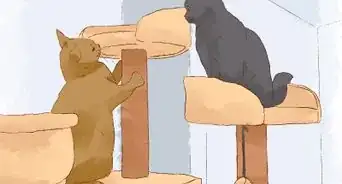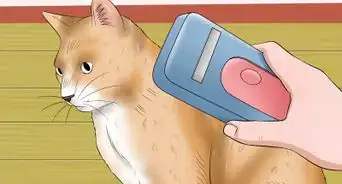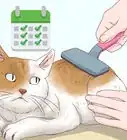This article was co-authored by Pippa Elliott, MRCVS. Dr. Elliott, BVMS, MRCVS is a veterinarian with over 30 years of experience in veterinary surgery and companion animal practice. She graduated from the University of Glasgow in 1987 with a degree in veterinary medicine and surgery. She has worked at the same animal clinic in her hometown for over 20 years.
wikiHow marks an article as reader-approved once it receives enough positive feedback. This article has 28 testimonials from our readers, earning it our reader-approved status.
This article has been viewed 1,377,447 times.
Petting a cat may sound simple, but for children or people who haven't spent much time around cats, it's important to know the do's and don'ts of approaching and touching a cat. Petting in the wrong spot or using too much force or speed can agitate some cats, causing them to bite or scratch. Experts recommend letting it happen on the cat's terms: seek permission to touch them, and let the cat have control over the interaction. There are a few places where it's hard to go wrong: areas where cats have scent glands are perfect for petting. Spreading their scent imbues their environment with a familiar smell, which in turn makes them feel happy and content.[1] Knowing where to touch, and when to stay away, can help ensure that both of you enjoy a little cat-human contact.
Steps
Focusing on Areas with Scent Glands
-
1
-
2Focus on the area between or behind the ears. Use the pads of your fingers and apply gentle pressure. The base of the ears is another scent-marking spot for cats.
- If they bump their head against you (called "bunting"), they are marking you as theirs.[4]
Advertisement -
3Pet the cat's cheeks just behind the whiskers. If the cat likes this, they may rotate their whiskers forward, effectively asking for more.[5]
-
4Run the back of your hand gently along the side of the face. Once the cat is warmed up, use your middle finger to stroke the cat's "mustache" (just above the upper lips) while encircling their whole face and stroking the top of the head with your thumb. The cat is yours.
-
5Stroke the cat from forehead to tail. Pet the forehead, then run your hand from forehead to the base of the tail, going from head to tail repeatedly. Massage their neck muscles by pinching gently. Apply gentle pressure and make it a continuous, slow motion. Work only in one direction (forehead to tail), as some cats do not like back-to-front strokes.
- Don't touch the tail or move your hand along to the side.
- If the cat likes what you're doing, they'll arch their back to add more pressure to your hand. When you bring your hand back to where you started, the cat may rub their forehead firmly against your hand to encourage you to do it again. If the cat puts their ears back, cowers away from your hand, or just walks away, stop petting.
- You can scratch gently as you bring your hand down along the cat's back, but don't stop at one spot and scratch there. Keep your hand moving.
- Apply a little pressure at the base of the tail, though with caution. This is another scent gland area, and there are cats that like getting scratched right here.[6] Others, however, have a habit of suddenly snapping their teeth at your hand when they've had enough.
Letting the Cat Come to You
-
1Let the cat sniff you before you pet them, so they can become comfortable with you. Extend a hand or finger and allow the cat a chance to touch their nose to you.
- If they show no interest in your hand or just stares at it suspiciously, reconsider your intention to pet them. Try some other time when the cat may be in a different mood.
- If the cat sniffs your hand, meows, and then rubs their chin or the side of their head against it, or brushes the side of their body on you, chances are they are open to being touched. Open the palm of your hand and softly touch their body.
-
2Wait for the cat to bump their head against you. When a cat bumps their head into your hand, it's a signal they want attention. If you are busy at the moment, at least pet them once or twice, to let the cat know you aren't ignoring them.
-
3Pet the cat once if they jump into your lap and lies down. See if they fidget. If they do, it may be that they just wants to lie there and relax, as humans are a great source of body heat. If they don't fidget, you can continue to lightly stroke their spine or in the spots described in Part 2.
-
4Stroke a cat when they are on their side. Cats love to be petted when they are on their sides. Lightly stroke the side that is facing up. If they meow or purr, they may be communicating enjoyment.
- Avoid the belly, though (see Part 3, Step 3).
-
5Understand how your cat communicates. The cat makes some low audible sounds (called purring). Purring is one way a cat signals that it feels sociable and wants attention. When accompanied by hip bumps, ankle twining or head bumping, it means your cat wants you to pet it right now. Sometimes one stroke is all the cat wants, like a handshake or a greeting, rather than a long hug and snuggle session.
- The loudness of a cat's purring denotes its happiness level. The louder the purring is, the happier the cat is at the time. A soft purr means that they are content, a loud purr means very happy. Excessively loud purring means over-excessive happiness, which can sometimes switch quickly to annoyance, so be careful.
-
6Watch for signs that the cat does not want to be petted anymore. Sometimes even petting that feels good to the cat can become overstimulating or irritating, particularly if it is repetitive. If you're not paying attention, the sign to stop may come in the form of a soft, inhibited bite or scratch. Often, however, the cat gives several subtle signals before biting that they do not want to be petted anymore. Look for these advance warnings, and if you see them, stop petting:
- Ears flattening against the head
- Tail twitching
- Fidgeting
- Growling or hissing[7]
Learning What to Avoid
-
1Keep your petting from the head to the tail and don't switch directions. Some cats do not like getting stroked from tail to head.
-
2Don't pat the cat. Some cats enjoy it, but some don't, and if you're not used to being around cats, you're better off not experimenting unless you want to risk a bite or scratch.
-
3Stay away from the belly. When cats are relaxed, they might roll onto their back and expose their belly.[8] Don't always take this as an invitation to rub their tummy, as many cats don't like that at all. This is because in nature cats must be careful to protect themselves from potential predators (as opposed to dogs, who are more confident in this regard – and love having their bellies scratched). The stomach is a vulnerable area where all the vital organs are located, so lots of cats will instinctively bare teeth and claws if touched here.[9]
- Some cats do like it, but they interpret it as an invitation to play rough or wrestle with claw-grabbing and scratching. They'll wrap their claws around your hand or arm, bite it, and scratch at it vigorously with their front and back paws. This is not always an attack; it's how some cats "wrestle."
- If a cat grabs you with its paws, hold still and let the cat disengage their claws. If necessary, reach over with your other hand and gently pull the paw back to unhook the claws. Cats often scratch deep when they don't intend to if their claws get stuck. They use claws to hold and grab, so when the message is for you to stop moving your hand, they'll stop if you stop.
-
4Approach the feet with caution. Don't play with a cat's feet unless you know the cat well and know they like having their feet played with. Start just by petting the cat to get them relaxed, then ask permission to stroke their feet by touching one foot once with your finger.
- Many cats don't like their feet handled at all, but can be trained into it for activities like claw clipping through a slow, successive reward system.
- If the cat doesn't object, lightly pet that foot with one finger in the direction the fur flows (from wrist toward toes). At any point the cat pulls their foot away, hisses, flattens their ears or walks away, stop.
How Do You Tell if a Cat Is Stressed?
Expert Q&A
-
QuestionCan cats be trained?
 Pippa Elliott, MRCVSDr. Elliott, BVMS, MRCVS is a veterinarian with over 30 years of experience in veterinary surgery and companion animal practice. She graduated from the University of Glasgow in 1987 with a degree in veterinary medicine and surgery. She has worked at the same animal clinic in her hometown for over 20 years.
Pippa Elliott, MRCVSDr. Elliott, BVMS, MRCVS is a veterinarian with over 30 years of experience in veterinary surgery and companion animal practice. She graduated from the University of Glasgow in 1987 with a degree in veterinary medicine and surgery. She has worked at the same animal clinic in her hometown for over 20 years.
Veterinarian Yes they can. You need to find a treat the cat really loves and is prepared to work for. Then used a reward-based training method, teaching little but often
Yes they can. You need to find a treat the cat really loves and is prepared to work for. Then used a reward-based training method, teaching little but often -
QuestionHow do you get a cat to like you?
 Pippa Elliott, MRCVSDr. Elliott, BVMS, MRCVS is a veterinarian with over 30 years of experience in veterinary surgery and companion animal practice. She graduated from the University of Glasgow in 1987 with a degree in veterinary medicine and surgery. She has worked at the same animal clinic in her hometown for over 20 years.
Pippa Elliott, MRCVSDr. Elliott, BVMS, MRCVS is a veterinarian with over 30 years of experience in veterinary surgery and companion animal practice. She graduated from the University of Glasgow in 1987 with a degree in veterinary medicine and surgery. She has worked at the same animal clinic in her hometown for over 20 years.
Veterinarian Less is more. Avoid staring directly at the cat. Instead, sit quietly and scatter a few treats near your feet. Wait for the cat to come to you and then drop her more treats. Only reach out to stroke her once she is confident enough to bump her head against your legs or hand.
Less is more. Avoid staring directly at the cat. Instead, sit quietly and scatter a few treats near your feet. Wait for the cat to come to you and then drop her more treats. Only reach out to stroke her once she is confident enough to bump her head against your legs or hand. -
QuestionWhere do cats like to be petted?
 Pippa Elliott, MRCVSDr. Elliott, BVMS, MRCVS is a veterinarian with over 30 years of experience in veterinary surgery and companion animal practice. She graduated from the University of Glasgow in 1987 with a degree in veterinary medicine and surgery. She has worked at the same animal clinic in her hometown for over 20 years.
Pippa Elliott, MRCVSDr. Elliott, BVMS, MRCVS is a veterinarian with over 30 years of experience in veterinary surgery and companion animal practice. She graduated from the University of Glasgow in 1987 with a degree in veterinary medicine and surgery. She has worked at the same animal clinic in her hometown for over 20 years.
Veterinarian This depends on the cat as they all have different favorite spots. Some like an ear rub, others a chin rub, but the safest area if you aren't familiar with a particular cat is to gently stroke along their back, in the direction the fur lies.
This depends on the cat as they all have different favorite spots. Some like an ear rub, others a chin rub, but the safest area if you aren't familiar with a particular cat is to gently stroke along their back, in the direction the fur lies.
Warnings
- If you are wounded due to a serious bite or scratch, wash the affected area thoroughly with an antibacterial soap and apply an antiseptic. Then, seek medical assistance. Deep puncture wounds need medical attention because of the risk of serious infection.⧼thumbs_response⧽
- Don't pet a cat if they are uncomfortable.⧼thumbs_response⧽
- Don't pet the cat if you have allergies.⧼thumbs_response⧽
- If the cat looks aggressive, stay away as it can cause injury through bites and scratches.⧼thumbs_response⧽
- Children should be closely supervised when petting a cat. They can easily agitate the cat, causing the cat to bite or scratch. Cats that are friendly to adults are not always friendly to children. Be especially careful that children do not get their face too close to a cat.⧼thumbs_response⧽
References
- ↑ http://www.vetstreet.com/dr-marty-becker/four-places-to-pet-your-cat-and-one-to-leave-alone?page=2
- ↑ http://www.vetstreet.com/dr-marty-becker/four-places-to-pet-your-cat-and-one-to-leave-alone?page=2
- ↑ http://www.cat-world.com.au/General-Cat-Articles/how-to-pet-a-cat.html
- ↑ http://www.vetstreet.com/dr-marty-becker/four-places-to-pet-your-cat-and-one-to-leave-alone?page=2
- ↑ http://www.vetstreet.com/dr-marty-becker/four-places-to-pet-your-cat-and-one-to-leave-alone?page=2
- ↑ http://www.vetstreet.com/dr-marty-becker/four-places-to-pet-your-cat-and-one-to-leave-alone?page=2
- ↑ https://www.aspca.org/pet-care/virtual-pet-behaviorist/cat-behavior/petting-induced-aggression
- ↑ http://www.catbehaviorassociates.com/why-you-shouldnt-pet-your-cats-belly/
- ↑ http://www.vetstreet.com/dr-marty-becker/four-places-to-pet-your-cat-and-one-to-leave-alone?page=2
About This Article
All cats are different, and some love being pet while others don’t. Before you try to pet a cat, let it sniff your hand to show that you’re not a threat. If the cat backs away, flattens its ears, growls, hisses, or widens its eyes, give it some space so you don’t get scratched or bitten. If the cat seems relaxed, you can try petting it. Most cats enjoy being pet on the back of the head, under the chin, and behind the ears. Some cats will let you pet them along their back too. Be gentle and pet in the direction the cat’s fur grows in. A lot of cats dislike being pet on their belly, tail, legs, and paws, so try to avoid these areas. To learn how to interpret other signs and signals the cat might give you, read on!

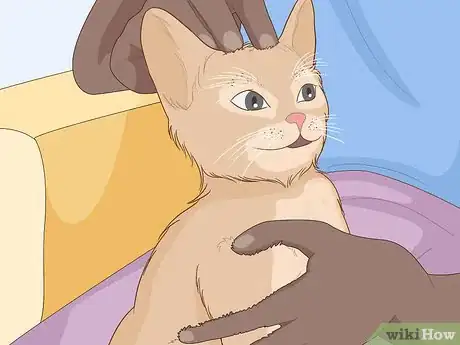

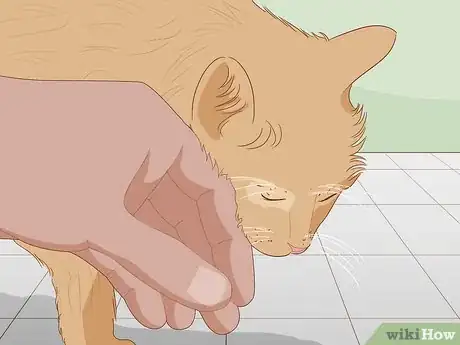
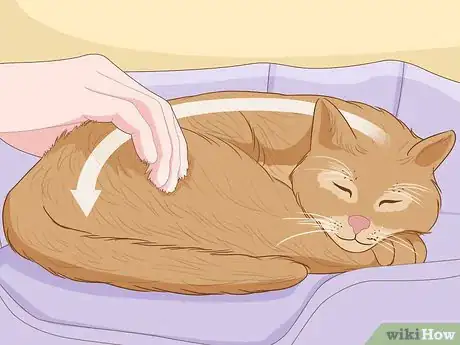
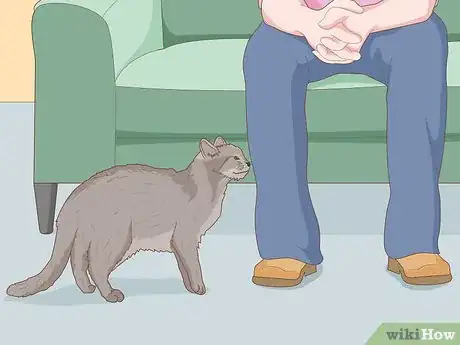
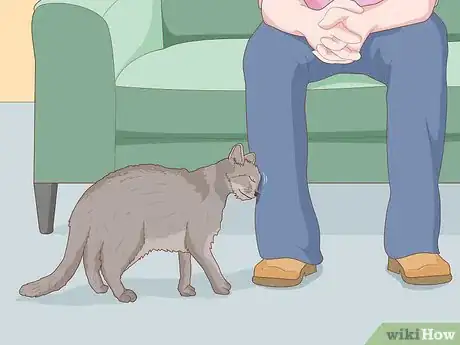
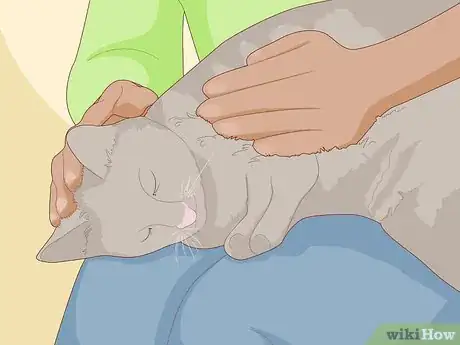
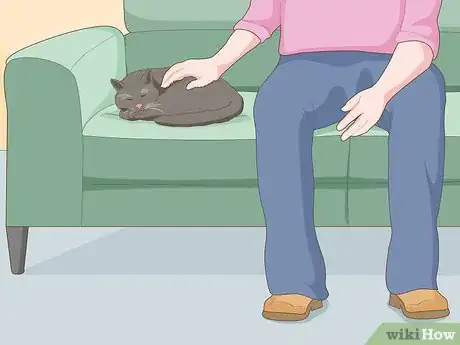

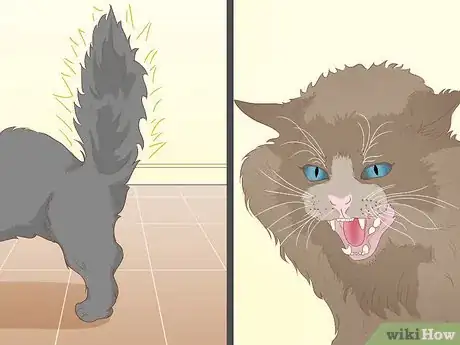
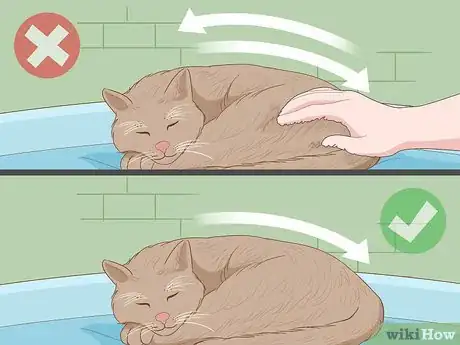
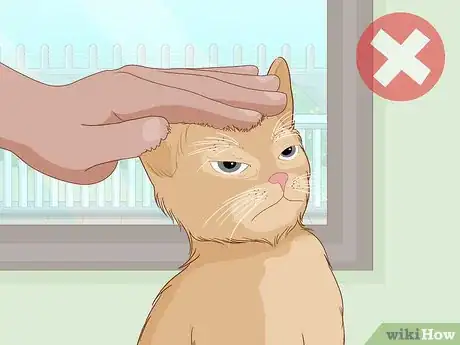
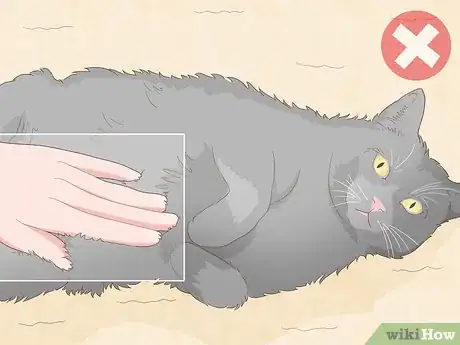

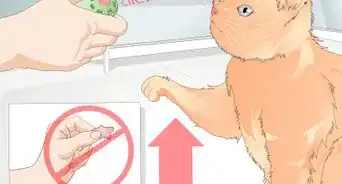
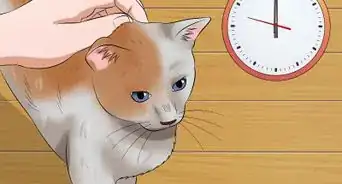
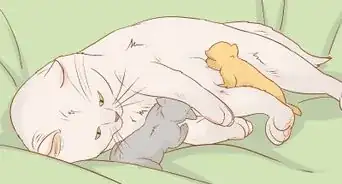


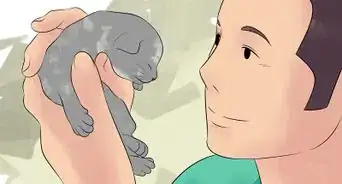
-Step-11-Version-6.webp)


